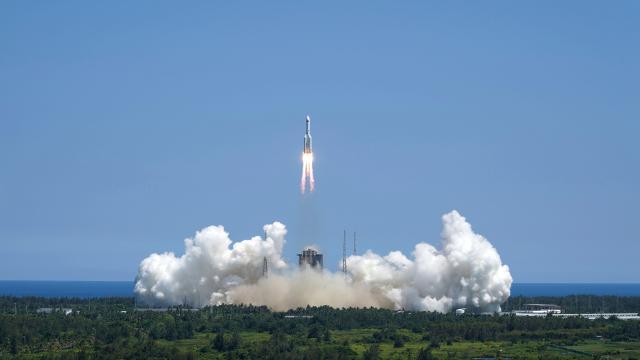The core stage of a Long March 5B rocket is hours away from performing an uncontrolled reentry and crashing onto the planet’s surface. Here’s the latest on this unfolding event.
China launched the Long March 5B on July 24, delivering the Wentien module to the nation’s Tiangong space station. As expected and feared, the core stage entered into a rapidly deteriorating elliptical Earth orbit and is now poised to make an uncontrolled reentry into the atmosphere.
The Aerospace Corporation’s Centre for Orbital Reentry and Debris Studies (CORDS) is tracking the object and providing regular updates on the situation. The current estimate has the 23 T rocket body plunging through Earth’s atmosphere on Sunday, July 31, at 4:26 a.m. AEST, with an error bar of plus-minus 6 hours.
NEW: This picture is a zoomed in version of the map above, reflecting the prediction of 30 Jul 2022 18:26 UTC ± 6 hours. The exact locations of these lines is expected to shift slightly with future predictions. pic.twitter.com/maE1oRaiBg
— The Aerospace Corporation (@AerospaceCorp) July 29, 2022
Looking at The Aerospace Corporation’s map, the white line and shaded area represent the day/night boundary around the globe. The blue lines show the object’s orbital path before reentry, and the yellow lines are the predicted future path of the booster (each tick mark is a five-minute interval). The text label shows where the object is predicted to land, and the orange circle shows the area within which the booster’s reentry can be seen from the ground. These estimates are rough and will improve as we near the time of reentry. Even still, “a one-hour error in the reentry time is an 28,968 km error in the location,” as Jonathan McDowell, an astrophysicist at the Harvard-Smithsonian Centre for Astrophysics, told me last year.
When the crash finally does happen, it typically takes a few hours for tracking stations to announce the exact time and place of the impact.
Normally, core stages don’t reach as far as orbit and are directed toward unpopulated areas, such as the ocean, but that’s not the case in this situation. This appears to be the pattern with Long March 5B rockets, as two previous launches, one in 2020 and one in 2021, resulted in similar uncontrolled reentries.
The Aerospace Corporation predicts that upwards of 20% to 40% of objects this size will reach the ground, but the chances of being hit and injured by reentering debris are less than one in 1 trillion (but it has happened!). It’s therefore highly unlikely, but not impossible, that the 30.48 m-long (30-metre) rocket body will kill or hurt someone or damage property, and it appears that China’s space agency is gambling on those low odds.
“The spread of debris, referred to as the ‘debris footprint,’ is not something experts can speculate on at this time, given the degree of uncertainty remaining for the reentry point,” according to The Aerospace Corporation. Previous uncontrolled reentries of the Long March 5B saw debris fall along the west coast of Africa and into the Indian Ocean near the Maldives.
Fingers are firmly crossed for another harmless ending.
More: Congress Sneaks NASA Authorization Bill Into CHIPS, Approves Moon-to-Mars Program.
